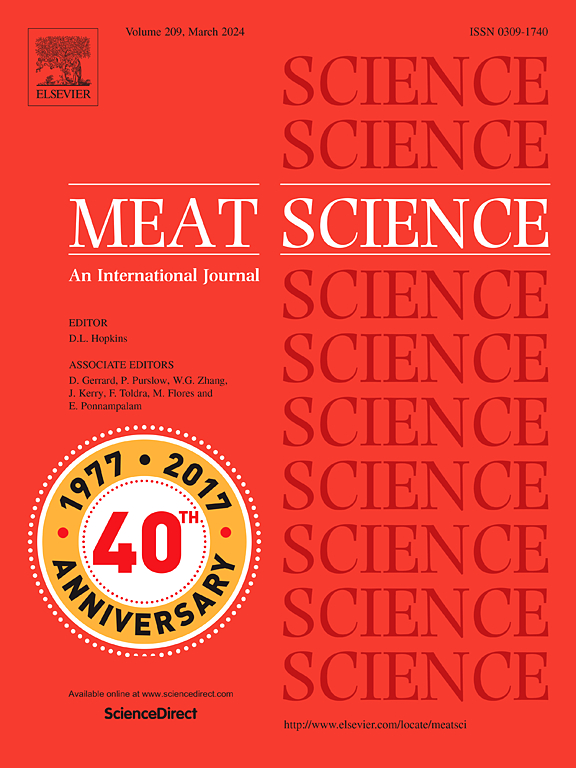Effect of super-fast freezing before rigor mortis on quality of bovine M. longissimus lumborum
IF 6.1
1区 农林科学
Q1 Agricultural and Biological Sciences
引用次数: 0
Abstract
In order to explore the effects of super-fast freezing (SFF) on beef quality, conventional chilling (CC, 0 ± 2 °C) and very fast chilling (VFC, hot-boned beef loins chilled at −30 °C and then stored at 0 ± 2 °C to bring the temperature down to 0 °C within 5 h post-mortem) were used as controls to investigate the effects of three SFF treatments (−30 °C until the core temperature decreased to −3 °C (SFF–I), −7 °C (SFF–II) and −10 °C (SFF–III), and then stored at 0 ± 2 °C until 24 h post-mortem) on beef tenderness, meat color, water holding capacity, and other related indicators. The results showed that both SFF and VFC improved the tenderness of beef at the early stage of storage compared with CC, and of these SFF–II and SFF–III were the most effective. The SFF has the potential to reduce the cooking loss but increases the purge loss of beef. In addition, SFF has a negative effect on the meat color, but the a* value is still within the acceptable range of consumers. After being treated by SFF, the rate of beef glycolysis was delayed post-mortem. In addition, SFF treatment did not cause a large degree of shortening of sarcomere, but disrupted the muscle fiber structure, contributing to the improvement of muscle tenderness. The results indicate that pre-rigor beef muscles can be deeply frozen, which will not cause obvious shortening with proper freezing and thawing procedures.
尸僵前超高速冷冻对牛腰最长肌质量的影响
为了研究超高速冷冻的影响(设定触发器)牛肉质量,传统的冷却(CC、0±2°C)和快速冷却(由变频控制,hot-boned牛肉腰冷冻−30°C,然后储存在0±2°C来降低温度在5 0°C h事后)被用作控制调查的影响三个设定触发器治疗(−30°C到核心温度下降到−3°C (SFF-I), 7°C (SFF-II)和−−10°C (SFF-III),然后在0±2℃保存至死后24 h),观察牛肉的嫩度、肉色、保水能力等相关指标。结果表明,与CC相比,SFF和VFC均能改善牛肉贮藏初期的嫩度,其中SFF - ii和SFF - iii效果最好。SFF具有减少牛肉蒸煮损失的潜力,但增加了牛肉的清洗损失。此外,SFF对肉色有负面影响,但a*值仍在消费者可接受的范围内。经SFF处理后,死后牛肉糖酵解速率延迟。此外,SFF治疗并没有造成肌节的大程度缩短,但破坏了肌纤维结构,有助于肌肉压痛的改善。结果表明,在适当的冷冻和解冻过程中,牛肉肌肉可以深度冷冻,不会产生明显的缩短。
本文章由计算机程序翻译,如有差异,请以英文原文为准。
求助全文
约1分钟内获得全文
求助全文
来源期刊

Meat Science
工程技术-食品科技
CiteScore
12.60
自引率
9.90%
发文量
282
审稿时长
60 days
期刊介绍:
The aim of Meat Science is to serve as a suitable platform for the dissemination of interdisciplinary and international knowledge on all factors influencing the properties of meat. While the journal primarily focuses on the flesh of mammals, contributions related to poultry will be considered if they enhance the overall understanding of the relationship between muscle nature and meat quality post mortem. Additionally, papers on large birds (e.g., emus, ostriches) as well as wild-captured mammals and crocodiles will be welcomed.
 求助内容:
求助内容: 应助结果提醒方式:
应助结果提醒方式:


